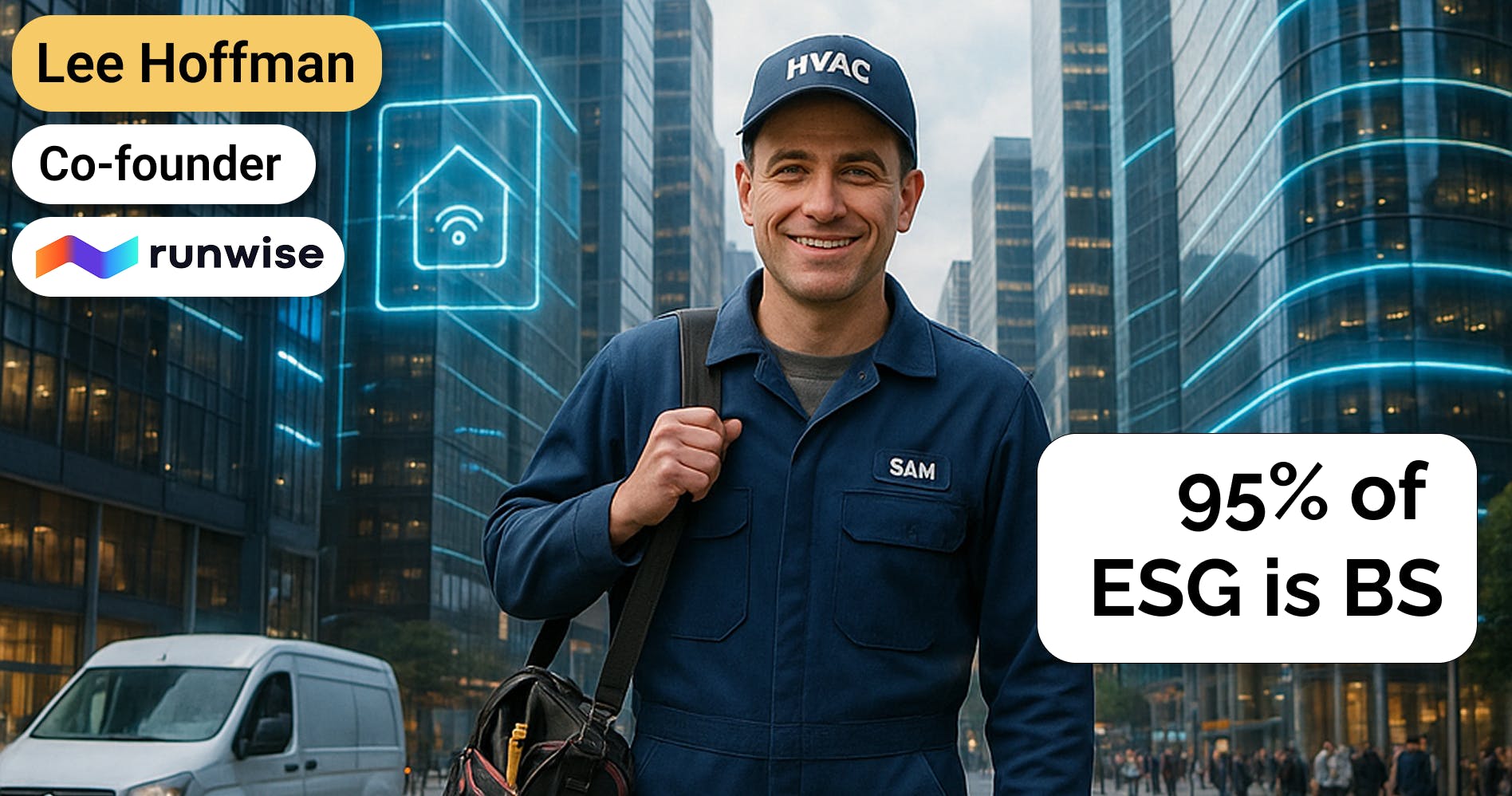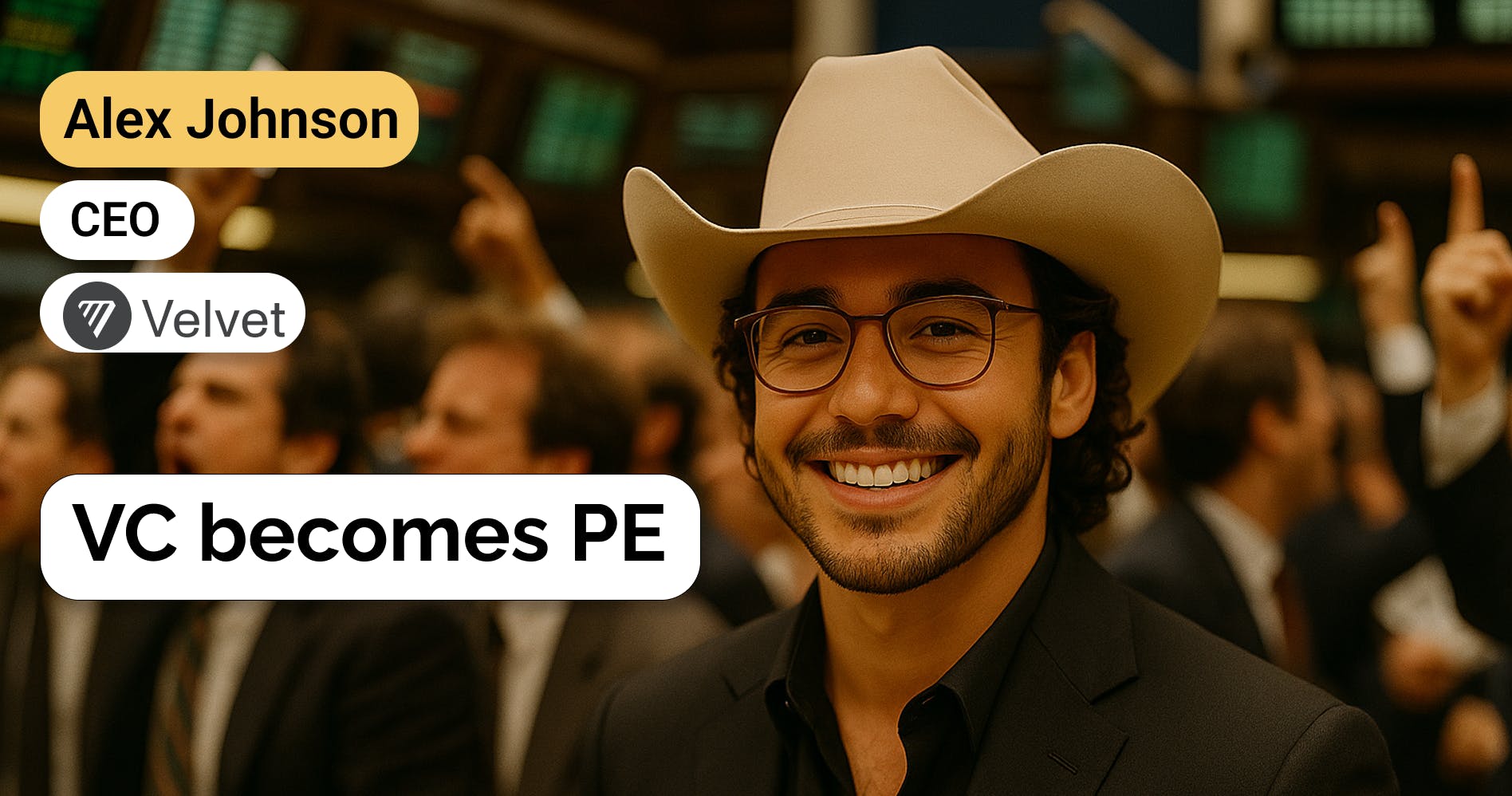Lee Hoffman, co-founder of Runwise, on the operating system for buildings
 Jan-Erik Asplund
Jan-Erik Asplund

Background
With ESG money drying up and regulations & higher interest rates squeezing landlords, building owners are looking for “smart” upgrades that pay for themselves fast.
To learn more, we spoke with Lee Hoffman, CEO of Runwise ($35M raised, Fifth Wall), which runs in 10,000 commercial and residential buildings.
Key points from our conversation via Sacra AI:
- Despite billions flowing into ESG and climate tech startups during 2020-2021, most have failed to gain traction because they don’t deliver tangible financial and operational savings to owners & operators of real estate—who operate at the limit of profitability and face increasing economic pressures from interest rates, regulations, and labor & energy costs. "Owners and operators of real estate are among the hardest people in the world to sell to. They're insanely busy... dealing with one fire and catastrophe after another - the ceiling collapsed here, getting hit with violations, tenants suing... Those are their top priorities, not implementing new solutions to make the business run better.”
- In a 2025 Trump-era push for abundant energy, vertically integrated hardware & software delivers the “smart” & adaptive UX at the grid layer (Base Power, Tesla), load balancing to prevent brownouts, and at the building layer, retrofitting mid-century boilers and chillers to operate efficiently across America’s 12 million commercial & multifamily properties. “At the end of the day, if you're running anything important that touches people's lives, do you want to run it with intelligence, or with no technology whatsoever? …You're still going to need to know how the building is running. Are algorithms making decisions instead of humans turning knobs? Are critical issues popping up that need addressing? These needs will remain regardless of energy saving.”
- Building-control incumbents—Honeywell, Johnson Controls, Siemens—still ship mostly hardware with thin software layers and sell through HVAC middlemen, while a new wave of vertically integrated platforms such as Runwise ($35M raised, Fifth Wall), 75F ($81M raised, Breakthrough Energy Ventures), and BrainBox AI ($103M raised, ABB) go direct to owners, drop in wireless sensors and controllers, and layer on browser-based & mobile software dashboards and control center experiences for predictive maintenance, real-time load shifting, and tenant-visible comfort dashboards. “Any industry with a heavily physical component requires vertically integrated hardware and software products. Typically, the end player in that market ends up being one or two companies because it's so capital intensive. The same thing is happening in buildings. You have Honeywell, Johnson Controls, Siemens, Heat Timer... multi-hundred billion dollar hardware companies making mechanical devices with terrible software, not selling directly but through networks of HVAC companies and engineers. They're getting wiped out by vertically integrated hardware-software sold direct.”
For more, check out this other research from our platform:
- ServiceTitan: the $577M/year vertical SaaS for your lawn
- Ameet Shah, partner at Golden Ventures, on the economics of vertical SaaS marketplaces
- Warren Brown, VP of Product at Order, on 4 ways to monetize payments in vertical SaaS
- Jareau Wadé, Chief Growth Officer at Finix, on building payments infrastructure for SaaS companies
- Hadi Rashid, co-founder of Lunchbox, on vertical SaaS for restaurants
- Contractor Payroll: The $1.4T Market to Build the Cash App for the Global Labor Market
- Owner at $34M ARR
- Matt Velker, CEO of OpenWrench, on the taxonomy of the maintenance services SaaS space
- Alexis Rivas, CEO of Cover, on building the Tesla for homebuilding
- Ryan Miller, VP & GM of Private Markets at Persefoni, on building an ERP for carbon
- Paul Gambill, CEO of Nori, on tokenized projects for social good
- Brennan Spellacy, CEO of Patch, on the API layer of the carbon stack
Questions
- In short, what is Runwise?
- if Runwise is the OS for the building, what’s the PC? What’s the common hardware that it’s all built on? You would think all these systems would be very heterogeneous, so how does Runwise make this happen?
- Is it effectively some kind of reverse engineering of whatever boiler is in place? Obviously, there's no API connected to these boilers or any kind of integration stuff out there.
- You mentioned 10+ years. You guys started as HeatWatch, and I wanted to jump back a little bit and ask what was the original founding insight with HeatWatch? What did you learn that you brought into Runwise from that?
- Some of the types of customers you sell into are notoriously resistant to technology—how do you acquire them and how do you deal with pushback to learning your software? how do you acquire and onboard and install for a new customer? maintenance teams, sales teams?
- You spoke to the bareness of software in this space. I'm wondering if there are any other products in related spaces - if we made a market map of related products here, are there other software tools that folks are using for maintenance on their buildings?
- You mentioned the positive ROI and shortening the timeline to seeing that as much as possible. You also mentioned this upfront cost versus ongoing cost. Does that map to the hardware and software components of Runwise? And do you think about Runwise primarily as a hardware or software business?
- You mentioned it's capital intensive, so are you making up the money on the hardware over time via this ongoing subscription model?
- There's a big picture context - Trump got elected president. He's not a big fan of ESG. It's also interesting that Elon doesn't really talk about Tesla anymore as a climate company. Do you see ESG/climate as a tailwind? Or regulations in liberal stronghold cities as a tailwind? How do you see that?
- The other side of the Trump/American dynamism vision is energy abundance - creating a world where energy is cheap and abundant. One might assume in such a world, something like Runwise is less important. Why would that be wrong?
- Going into the Tesla analogy a bit more, I'm curious - if Runwise is in every building in New York or every building in a major metro area, what does that enable you to do that doesn't exist today?
- We're looking at Tesla's grid-scale solutions and companies like that working on battery power. But as you've talked about, the majority of the built environment is still very under-optimized, running on sixties/seventies hardware. Where is the low-hanging fruit in climate building energy tech? Is it new infrastructure or the retrofitting strategy you've taken on?
- We've done a fair amount of coverage of companies doing carbon accounting, carbon offsetting, dashboards, reporting tools. Is that something you've thought about, as you operate at the layer where you can actually see and have an impact on the amount of carbon being generated?
- How do you think about expansion from a business point of view? Do you have to go Uber-style, winning markets city by city on the ground, or is there a way to scale faster?
- You started with heat and added other modules like leak detection and gas monitoring. How did you sequence it, and how do you think about what to add next?
- You have partnerships with Con Ed and National Grid. Can you talk about that? What's the incentive for them to work with you and have these installed in buildings they service?
- Last question - if everything breaks correctly for Runwise over the next five years, what does Runwise look like and how has the world changed?
Interview
In short, what is Runwise?
Software has changed every industry in the world, but if you go to pretty much any building, there's virtually no software running anything. There's software outside the building for leasing systems, but all the key systems - heating, cooling, water, electric, lights - are running on either nothing or archaic 1970s basic technology. The result is tremendous energy waste. Buildings are not very safe, typically not very comfortable, and very hard to manage. Usually, you have to go to a specific room in the building to turn switches to change things or check if something's happening.
We've created a way of putting a modern operating system - a new brain - into buildings that's 20-30 times cheaper than what historically existed because we do it completely wirelessly. We invented a wireless protocol that allows us to blanket a building very quickly, then everything we do is wireless and battery-powered. This allows us to put this brain in the building in a day or less, which is about 20-30 times faster and cheaper than anybody else. We can then run every system in the building much more intelligently, more energy efficiently, in a safer way, a more comfortable way, and make it much easier to manage. That's essentially what we do in close to 10,000 buildings right now.
if Runwise is the OS for the building, what’s the PC? What’s the common hardware that it’s all built on? You would think all these systems would be very heterogeneous, so how does Runwise make this happen?
One interesting thing about this - if you think about Tesla, they're modernizing and turning cars into software systems. The beauty of Tesla is you can build it from scratch, building all the hardware and merging it together. For us, we have to go into existing buildings, and every building is a unique snowflake in how it's built, what types of heating systems, cooling systems, how they work together, how the electric system is set up.
Our job is to use wireless technology and vertically integrated hardware and software components to go into any building in the world, be in and out in a day or less, and take control of everything in a much more intelligent way - reducing energy usage by 10-30%, making the building completely remotely automated and controllable, detecting every critical issue that can possibly arise, and doing it 100% of the time in every situation.
It's a very hard challenge. It has been literally a decade of R&D. We invented a new wireless protocol that dramatically outperforms LoRaWAN and all other wireless technologies out there. We invented new battery technology to make this possible. We invented all the software algorithms - we have a whole research team that figures out how to squeeze an extra 1-2% out of chillers, cooling towers, boilers, etc. every single year. It's a very heavy R&D company driven by ten years of being able to go into every building and predictably deliver results and financial returns extremely quickly in every situation.
Is it effectively some kind of reverse engineering of whatever boiler is in place? Obviously, there's no API connected to these boilers or any kind of integration stuff out there.
Definitely not. If you boil it down, there are probably six or seven major types of heating systems, five major types of central cooling systems, etc. You're basically looking at how to take control of that, what you need to monitor, how to connect to it, and how to run it much more intelligently using sensors, weather forecasts, and prediction models. Then you're constantly measuring and improving your systems to do better over time.
It's not a huge long tail in the type of heating system, but it is a long tail in the brand, the year, and what weird things are going on in the building. But the broad categories of heating and cooling systems make the general overview consistent.
You mentioned 10+ years. You guys started as HeatWatch, and I wanted to jump back a little bit and ask what was the original founding insight with HeatWatch? What did you learn that you brought into Runwise from that?
We always had the same vision - there's literally no intelligence in any part of the building. If you could dramatically lower the cost of getting physical hardware installed in the building, you could run every system much more intelligently. And if you do it right, once you control one thing, it's dramatically cheaper to control the next, and the next.
What we did differently than everybody else in the market - and the reason we've succeeded where others failed - comes down to two basic insights. First, the key to get scale and make building owners actually do things quickly is to deliver an ROI not in five years, but in a few months. We worked backwards from that goal, literally vertically integrating down to designing wireless chipsets and battery technology to deliver on that ROI.
The second part is that everybody else tries to do everything at once. It's tempting when you're a startup to say "I convinced this owner to buy my thing, I'm going to do everything in their building." That's a mistake. It took us years to get just one heating system - a single pipe heating system - to predictably cut energy usage 20% every time.
Then it took time to master two-pipe heating systems, steam systems, ironic systems, three-way valve systems - all the different types. We started very narrow, focused on being awesome at one thing, and then slowly expanded.
We took Chris Dixon's wedge strategy until we basically ate all the systems in the building. That's a fundamentally different approach, and I don't think it's possible to do it the other way. If you try to do everything, you end up doing everything terribly.
We want to get data that's beyond the application layer, and you can only do that by being the operating system itself. There are many things you don't have access to as an app.
Some of the types of customers you sell into are notoriously resistant to technology—how do you acquire them and how do you deal with pushback to learning your software? how do you acquire and onboard and install for a new customer? maintenance teams, sales teams?
We've figured this out, but owners and operators of real estate are among the hardest people in the world to sell to. They're insanely busy. In most white-collar jobs, you're sitting at a desk with some downtime. These people are in the field all day, dealing with one fire and catastrophe after another - the ceiling collapsed here, getting hit with violations, tenants suing, apartments not rented costing thousands in lost rent daily. Those are their top priorities, not implementing new solutions to make the business run better.
Secondly, every building is run at the financial limit. This is how they were run twenty years ago and up to ten years ago, even when the market was great. You refinance the building, take out the maximum mortgage, and the building would basically be losing money every month. So you don't want to spend money on anything.
Then in the last five years, you've had fundamental changes in rent control laws, high interest rates, mortgages at all-time highs. Regulation costs have multiplied by 10 over the last decade. Labor costs are up. Energy costs are up. Everybody is under pressure. It is nearly impossible to get owners and operators to spend money.
The way we've broken the market is we go in and say, "Here's your building. We've done this so many times. We've looked at your energy bills. This is how much we're going to save you - $80,000 a year. We're going to charge you $10,000 upfront and $10,000 a year. So for $20,000 in the first year, you're going to save $80,000. And we'll guarantee it. If we don't deliver in a year, you get your money back. Zero risk. If I'm right, you're going to add $60,000 in NOI to your building overnight. Oh, and by the way, you also get modern technology that lets you control your building from anywhere, prevents issues and lawsuits, helps with carbon compliance, makes it easier to manage, makes your tenants complain less."
You buy it for the economics, then watch what happens. That gets high-velocity sales. Once they use it, that's when you see Related, Equity, Inventions, Moinian, Rudin, LeFrak, the MTA, LIRR, NJT, Port Authority - every one of these huge operators has this in almost every building. As soon as they put it in a couple, they realize they can't imagine going back to running their buildings on 1970s non-Internet-connected technology. That's how we've driven our scale and fast velocity sales.
You spoke to the bareness of software in this space. I'm wondering if there are any other products in related spaces - if we made a market map of related products here, are there other software tools that folks are using for maintenance on their buildings?
There's Building Link, Yardi and lots of leasing programs, but they're not really touching what we're touching, which is how you run the physical building itself - not how you manage the data and documents around the building, but the actual physical building.
There have literally been hundreds of startups and companies offering point solutions, but those solutions rely on the same old incredibly expensive controls that require miles of wiring and electricians on ladders for two weeks to install. So first, you have this huge upfront CapEx that no building owner will approve. And even if they do say yes, they have to say yes to solve just one point solution, which doesn't pencil out.
When you go in and say, "We're going to put in infrastructure to cut your heating bills 22%, and by the way, it's also going to cut your cooling bills 18%, monitor your gas detectors for Local Law 157, find all the running toilets, and the CapEx cost is nothing because everything is wireless and battery-powered, we'll be in and out in five hours" - suddenly it makes economic sense.
That's what's really differentiated us. Our goal is that by getting this into buildings, we can open up to other startups over the next few years, allowing thousands of startups with ideas and applications for buildings to say, "We already have the system in the building, there's minimal CapEx to get your application in, and you can distribute it to 50,000 buildings overnight." That's the vision of why we call it the operating system for buildings.
You mentioned the positive ROI and shortening the timeline to seeing that as much as possible. You also mentioned this upfront cost versus ongoing cost. Does that map to the hardware and software components of Runwise? And do you think about Runwise primarily as a hardware or software business?
It only works because it's a tight coupling of hardware with software. It's the combination of those. I thought we were a unique snowflake industry where hardware and software integration was our specific challenge and nobody else had gone through this.
Then I realized there have been a series of industries that have gone through this transformation. Basically, any industry with a heavily physical component requires vertically integrated hardware and software products. Typically, the end player in that market ends up being one or two companies because it's so capital intensive to build a suite of hardware and integrated software.
For example, 20 years ago, everybody had a cell phone from Nokia, Ericsson, etc. There were about six players in the market, each worth about $300 billion.
They were amazing at manufacturing thousands of different mechanical devices with pitiful or nonexistent software, and they didn't sell them directly - they had distribution through thousands of cell phone stores.
The thought that one or two companies would come in and totally dismantle the entire market in five years would have been laughable. But that's exactly what happened with vertically integrated hardware and software from Android and Apple.
I think the same thing is happening in cars. You have many $50-100 billion car companies amazing at making mechanical devices with great distributor networks not selling directly, and they're going to get wiped out by vertically integrated hardware-software from Tesla, Google, robotaxi armies.
The same thing is happening in buildings. You have Honeywell, Johnson Controls, Siemens, Heat Timer, etc. - multi-hundred billion dollar hardware companies making mechanical devices with terrible software, not selling directly but through networks of HVAC companies and engineers. They're getting wiped out by vertically integrated hardware-software sold direct.
You mentioned it's capital intensive, so are you making up the money on the hardware over time via this ongoing subscription model?
Our whole job is figuring out how cheaply we can get the install cost and hardware over time to the point where eventually it's nothing. We show up, we're out in an hour or two, here's your yearly fee, and you're going to save 8-10 times that fee every year while getting this modern operating system running your building. That's the long-term vision.
There's a big picture context - Trump got elected president. He's not a big fan of ESG. It's also interesting that Elon doesn't really talk about Tesla anymore as a climate company. Do you see ESG/climate as a tailwind? Or regulations in liberal stronghold cities as a tailwind? How do you see that?
This is my controversial take, but I think the changes in ESG focus away from ESG and the government are the best thing that ever happened to our industry. When ESG was a major thing, tons of money was being thrown at honestly pretty shitty products and services.
I've always believed that the only way you solve climate is by starting and ending with products that are better for people, and then as a byproduct, better for the climate - not building products that are great for the climate but shitty for people. 95% of what's built in the ESG/climate space is shitty for people and great for the climate, and all those things disappear when subsidies and hype go away.
We've grown faster than ever in the last year, partly because there's less noise and bullshit in the space. Tesla is a great example - they make a better car. It's self-driving, cheaper to operate, a better, faster ride, and also happens to be good for the environment. That's how you solve climate.
We are a drastically better way to run your building. We save you money, make the building easier to manage, safer, more comfortable. That's why you should implement us.
We're also happy to be becoming one of the largest reducers of carbon emissions in the world, but that's not the reason to build the company.
The reason people adopt it is because it's better for humans, makes buildings more financially stable and economically profitable, makes rents lower and housing costs lower in cities, and also makes cities cleaner.
You can't depend on "Do this because it's great for the climate but shitty for people." Regulations like that are bad for the world and won't get adopted at scale. You have to build things for people, and then the byproduct should be better for climate. Then you'll have an outsized impact.
The other side of the Trump/American dynamism vision is energy abundance - creating a world where energy is cheap and abundant. One might assume in such a world, something like Runwise is less important. Why would that be wrong?
Sam Altman says the cost of energy and intelligence will eventually go to zero. But nothing is going to zero tomorrow. When that changes, there's a whole singularity of things.
But at the end of the day, if you're running anything important that touches people's lives, do you want to run it with intelligence, or with no technology whatsoever?
One nice part right now is the huge energy savings gap. Eventually, if that goes away in ten years or whenever, you're still going to need to know how the building is running.
Are algorithms making decisions instead of humans turning knobs? Are critical issues popping up that need addressing? These needs will remain regardless of energy savings. Energy savings is just one nice component, not the only one.
Unless you believe the world is going to revert to using 1970s technology or eliminate all intelligence in running the places where we spend 90% of our time working and living, our business model remains strong.
Going into the Tesla analogy a bit more, I'm curious - if Runwise is in every building in New York or every building in a major metro area, what does that enable you to do that doesn't exist today?
There are a couple of different things. One is we're building a platform. The whole idea is enabling tens of thousands of startups to write code and deploy applications in buildings at a cost structure that was never physically possible before.
Obviously, the more buildings we have, the more benefit there is for those developers to build on the platform, and the more benefit end users and buildings get because more applications are available. So there's a flywheel effect there.
Second, everything in buildings is driven by data, intelligence, and training. The more data you have, the more you can train the AI, and the better the system gets. Those are the two major flywheels as we get larger.
We're looking at Tesla's grid-scale solutions and companies like that working on battery power. But as you've talked about, the majority of the built environment is still very under-optimized, running on sixties/seventies hardware. Where is the low-hanging fruit in climate building energy tech? Is it new infrastructure or the retrofitting strategy you've taken on?
There are 12 million buildings in the States alone, 50 million globally. It would be lovely to rebuild every building from scratch and design them better, but that's not going to happen.
Even if you did, you can have the most muscular body in the world, but if your brain doesn't know how to move the parts effectively, it doesn't matter how muscular you are.
The best ROI in any building is putting in a new brain to run what you have much more intelligently.
That doesn't mean it's not great to make huge capital upgrades and replace aging boilers with more efficient, downsized boilers or heat pumps - those are fantastic, but they're incredibly expensive, capital-intensive measures that might happen in a large number of buildings over 25 years, but certainly aren't happening at scale quickly.
And regardless of whether you have upgraded or old boilers, you still want software intelligence running them.
We've done a fair amount of coverage of companies doing carbon accounting, carbon offsetting, dashboards, reporting tools. Is that something you've thought about, as you operate at the layer where you can actually see and have an impact on the amount of carbon being generated?
I'm not an expert on carbon credits and accounting, but my gut instinct is that it's kind of bullshit and will probably go away or drop dramatically. I don't want to sound like I don't care about climate - I really do.
One thing that drives me is waking up every morning and seeing the huge climate impact we're having every day - hundreds of millions fewer fossil fuels being burned, less electricity used. That's a huge climate benefit and one of the things that drives me.
But the more I've looked into carbon credits, the more I see bullshit, fraud, and nonsense. When you boil it down, is there any human directly benefiting from buying or selling a carbon credit? No.
It's more like "Let's do something good for the climate that maybe long-term will be great for everybody." That's not how humans operate. People don't generally do things for some theoretical goal for humanity twenty years down the road - they do things because they believe it's better for them today.
If you want to have a dramatic impact on climate, you have to start and end with building things that make people's lives better today but also happen to be good for climate as a secondary benefit.
How do you think about expansion from a business point of view? Do you have to go Uber-style, winning markets city by city on the ground, or is there a way to scale faster?
We can scale quickly going city by city, and we're growing at pretty quick rates. It probably does look more like that for two reasons.
First, there's a density benefit to getting things installed, training people, and servicing the equipment - there's a physical component to it.
Second, when selling to a city, there's a local community aspect. We're taking over something critical - how your entire building operates.
People want to know that the building next door is also using it, and the buildings four blocks away. That makes people feel comfortable because cities are still very local. So far, this approach has been effective for us.
You started with heat and added other modules like leak detection and gas monitoring. How did you sequence it, and how do you think about what to add next?
All the founders and executives are constantly talking to customers, asking about their problems, where money is being wasted, what challenges they have. You hear common repeating things.
For example, Local Law 157 was passed in New York City requiring every building to have a gas detector. Building managers were terrified because currently when anyone calls 911 for gas smell, the city shuts off gas to the building, and it can take five years to get it back on.
Now imagine what happens when you have a gas detector that plays a message saying "Emergency! Emergency! Explosion risk imminent! Evacuate immediately! Call 911!" just because your pilot light is out.
You'll have thousands of people calling 911, buildings losing gas service for five years, costing millions to replumb the entire gas system - a terrifying prospect for managers and operators.
We heard that and wondered if we could build a device with the same temperature sensor for heating, cooling, and gas all in one. We worked on that and rolled it out, which has been a major product line for us.
So we listen to customers, see where the problems are, and try to find solutions that make buildings operate fundamentally better in an ROI-positive way.
You have partnerships with Con Ed and National Grid. Can you talk about that? What's the incentive for them to work with you and have these installed in buildings they service?
Most states have passed laws requiring utilities to put a surcharge on every invoice for energy efficiency.
The utilities then need to prove at year-end that they've driven energy efficiency improvements and carbon reductions with those dollars. They look for companies with the best dollar-per-carbon reduction, and we happen to be one of them.
Most major utilities will help cover some of the installation costs in some percentage of buildings. It's not a major driver of our sales, but it's a nice add-on. If somebody has a whole portfolio, maybe we find one building that has an incentive, and it just makes the decision a little easier.
Last question - if everything breaks correctly for Runwise over the next five years, what does Runwise look like and how has the world changed?
If everything goes correctly, you'll walk down the streets of any major city and on the front glass of buildings, there's a little display showing "This building has cut its carbon emissions 26%. It has detected 17 critical issues that would have harmed people. It has made the building 30% easier to manage and has 22% fewer complaints from people living in it."
When you zoom out, you see cities that are fundamentally cleaner, more affordable to live and work in, safer and more comfortable, and easier to operate and manage for the people with the hard jobs of managing these properties.
Landlords get a bad rap, and I understand why, but most in the industry are good, hardworking managers and operators whose job is to run these gigantic businesses and physical infrastructure with no technology.
That's a huge waste and opportunity. Our goal is to solve that and help hundreds of startups and technology companies with brilliant ideas deploy solutions at scale in buildings quickly to make the lives of everybody living and working in cities better.
Disclaimers
This transcript is for information purposes only and does not constitute advice of any type or trade recommendation and should not form the basis of any investment decision. Sacra accepts no liability for the transcript or for any errors, omissions or inaccuracies in respect of it. The views of the experts expressed in the transcript are those of the experts and they are not endorsed by, nor do they represent the opinion of Sacra. Sacra reserves all copyright, intellectual property rights in the transcript. Any modification, copying, displaying, distributing, transmitting, publishing, licensing, creating derivative works from, or selling any transcript is strictly prohibited.



